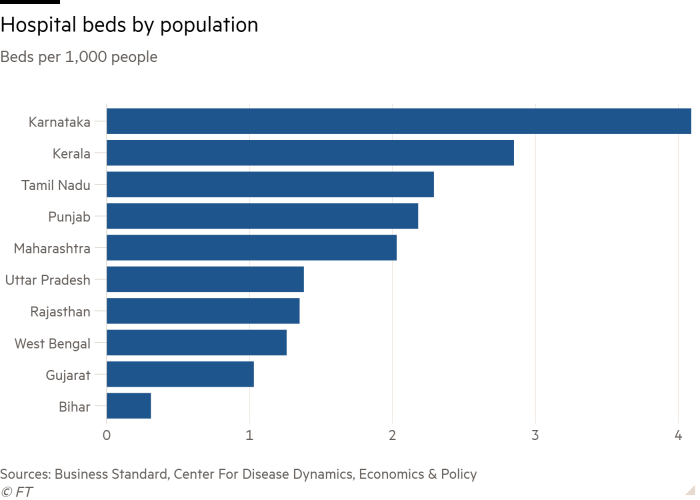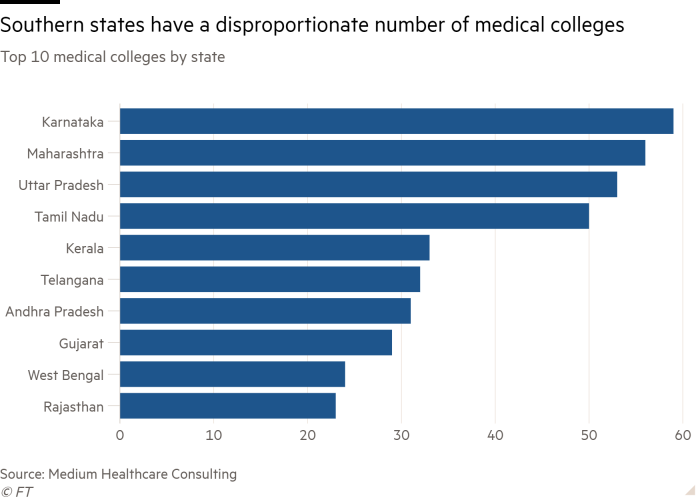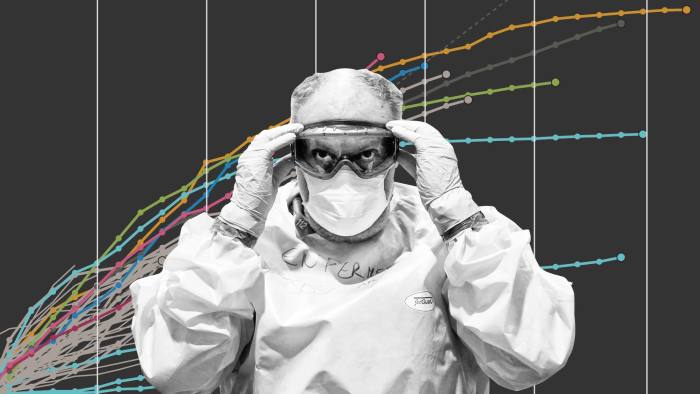Doctors in Vello, a city in the southern Indian state of Tamil Nadu, worsened when Covid-19 destroyed the country.
Coronavirus already had it beaten and overwhelmed the health system was moving across parts of India and south.
A doctor at the Christian Medical College in the city of Jacob John said his hospital was approaching a “breaking point”. Its 900 beds were filled, the hospital forced the patient to leave and the oxygen supply was near depletion.
But when India’s second-wave catastrophe hit Tamil Nadu and other southern states, places like Vellore suffered its worst outrage.
This has been due to the legacy of investment in primary and public health in the southern states, especially among the richest and most developed in India. Elsewhere in India, experts say the crisis has affected chronic health care neglect.
Tamil Nadu reports more infections than any other state, with 22,000 cases and nearly 500 deaths every day, and the five southern states of India have 900,000 active cases, half of the country’s current total.
“It simply came to our notice then. We don’t have enough ICU beds and there are patients who can’t adapt when they still come in, ”John said.“ I’m not saying we’re perfect… When the dust is definitely left, I’m sure those investments would save lives. ”
Before the second wave hit the south, it plagued health systems in many other parts of the country, including the capital New Delhi and Uttar Pradesh, India’s most populous state. Patients died from lack of oxygen and the crematorium was so overwhelmed that the bodies were dumped into rivers.
Southern states have experienced part of the tragedy, but experts say they have greater resistance.
“Because you have a fairly well-developed health infrastructure, horror stories weren’t as moving as in other states,” said Ratan Jalan, founder of Medium Healthcare Consulting and a former health executive. “There’s that protection that comes into play.”
The southern states of India account for about 250 million of the country’s nearly 1.4 billion people.
Kerala and Tamil Nadu are especially common in health, based on metrics like child death. Along with Karnataka, they also have more hospital beds and more medical faculties. The southern states of India dominated the ranking of states according to the sustainable development published last week by a group led by the UN and the government.
“People don’t have to do songs and dances to get to the Tamil Nadun hospital bed [some other parts of India]”Said anthropologist Lesley Branagan, who has researched health care in India.” That spirit of equity has been there for decades. ”

Although states like Western Maharashtra have also praised their response, there has been none more praised Rather than Kerala, last year the Covid-19 case was the first to be detected in India.
As the first wave of the first wave was very effective, it brought the reported cases to zero in a few days in May 2020. The number of cases rose by more than 40,000 a day last month, but has since dropped by half. The number of daily deaths has risen to almost 200.
Experts say Kerala and Tamil Nadu have tackled the crisis based on networks of primary care workers to help patients find treatment. They have also created “war rooms” to distribute resources such as oxygen, avoiding a devastating shortage.
The large numbers in the states were also a reflection of better testing, with experts highlighting greater transparency. They pointed out, however, that the minimum number of infections and deaths was widespread everywhere and that in some parts of the south, including Telangana, the response was frustrated by a lack of clarity.
Southern states, as well as Karnataka, went into detention last month, and cases have dropped.
Bangalore, the capital of Karnataka and the technology center of India, is still adding more cases than other big cities.

When the city’s Apollo Hospital opened its 30-bed Covid ward in late April, it was filled in 90 minutes, according to Ravi Mehta, head of critical care.
It expanded to more than 100 beds, all of which were occupied, and last month it ran out of oxygen and reached three hours. The pressure has eased, Mehta said, but the hospital’s intensive care unit remains full and is currently dealing with patients with serious complications. black fungus infections.
“In a month, that’s it [went] crazy, ”he said. “Now we need to pick up the pieces and give the best possible attention to those who are still struggling.”
The apparent success of the South hides deep differences within the region, as poor areas have less access to services. At least two dozen the patients died last month when they ran out of oxygen at a rural hospital in Karnataka. Goan, a southern tourist center, patient score they have died due to lack of oxygen.
Reuben Abraham, director general of the think tank at the IDFC Institute, said Tamil Nadu and Kerala have been waiting too long, which has weakened their response.
“Everything will depend on the maximum load [that a system can withstand]”It doesn’t matter how good your health care system is – I don’t care if it’s Switzerland, Kerala or the United States – the system will collapse when that peak load is dropped.”
Dr PV Ramesh, a senior official in Andhra Pradesh, said the crisis should force reflection on the failure of health across the country.
“This is seen as an oxygen supply crisis and not as a key governance crisis,” he said. “When the wave subsides. . . they will all return to business as usual and no education will be learned. “
Latest coronavirus news

Follow the FT’s live coverage and analysis of the global pandemic and the rapidly developing economic crisis here.



































